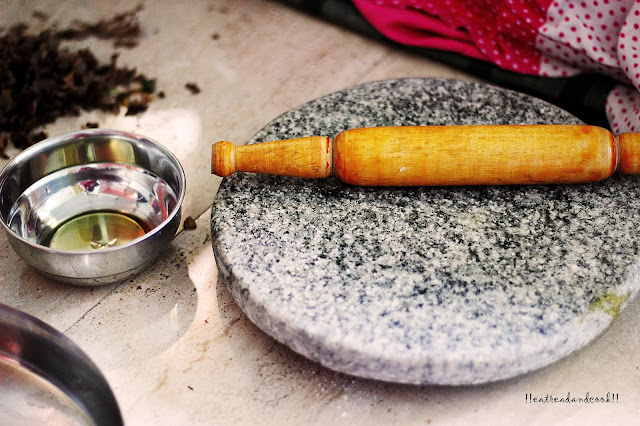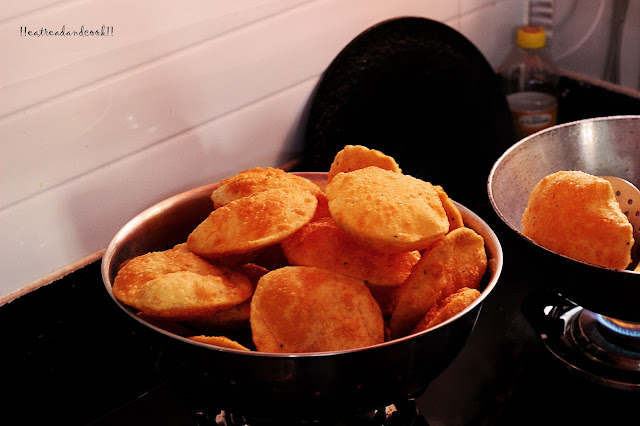Hing er Kochuri / Hing ~ Asafoetida flavoured Kachori
Hing er kachori / kochuri stirs up a lot of emotion down the memory lane, the most vivid being the one in Dakhineswar. I take it that if you are a Bengali or if you have your roots in Bengal, at least once in your life you have been to Dakhineswar, the abode of Ramakrishna and his Goddess Kali. Our family visits this place at least twice a year.
As a kid I did not have any emotional attachment to this
place but it was my mother who used to drag me there. We had to stand in a long queue before
we could have our turn to give our offerings to the god. Needless to say that I
didn’t like all these waiting under the sun much and so I used to wander around
the twelve temples of the Shiva just opposite to the Kali temple within the
compound with my sister. In each temple there is a huge brass bell with a thick
rope attached to it. If you pull the rope the bell rings. And we sisters used
to took turns in ringing those bells in each of the temples. And when Ma almost
reached the stairs we had to rush to her so that we can get a glimpse of the
Goddess Kali and bow our heads. The priests inside take away all the flowers,
garlands, sindur and everything that we buy from the shop outside the temple
for puja and gives a small box of prasad in that empty basket with some flowers
and a little paper consisting a little bit of the temple’s muddy sindur. The
prasad is usually the gujiya which tastes absolutely divine and ma used to give
a little touch of that sindur on everyone’s forehead before taking a little
smear of that sindur on her “nowa” (the iron bracelet she wears as a symbol of
marriage), on the part of her forehead, where she parts her hair to wear sindur
and also at the middle of the forehead, where she wears “bindi”.
After the puja we get to eat. And there are lots of small
restaurants outside the temple compound selling hot hot hing er kochuri and
cholar dal. We always ate there before taking the bus. I haven’t
gone there a while but I guess hardly anything has changed. These small
eateries serve on wooden benches and chairs and the atmosphere inside is kind of
clumsy and moist. If you stay there for a long time the pungent smell of hing
will make you flimsy. But the place is clean and they will serve you right
away. I didn’t like the place but I loved their kohcuri, and the cholar dal they
made with small bits of coconuts in them is outstanding.
So this year when my masi made hinge r kochuri in the
breakfast I could not resist and without giving any more thought toward its oil
content I ate almost 6 of them and had nalen gurer rosogolla in the end. People
say home is where your heart is. I disagree. For me home is where my loved ones
are.
Hing er Kochuri / Asafoetida Flavoured Kachori
Makes around 12-15 kachoris
Ingredients:
For the kochuri / kachori
1 and ½ cup all purpose flour
½ cup whole wheat flour
2 tbsp fine semolina
Salt
¼ cup ghee
1 cup luke warm water
For the stuffing:
½ cup husked urad dal / biulir dal / kolai er dal
A big pinch of hing (add more if required)
1 tsp nigella seeds
½ tsp crushed fennel seeds
1 inch ginger – peeled
2 green chillies
2 tsp mustard oil
Salt and a pinch of sugar
Oil to deep fry
Method:
Make the fillig:
Wash and soak the urad dal / kolai er dal / biulir dal
overnight in enough water.
Next day drain the water and put the dal in a blender.
Add a dash of water (just enough to make it a paste).
Add the green chillies and make a (not so fine) paste of
it.
Pour this paste in a bowl and add some salt to season.
Heat 2-3 tsp mustard oil in a kadai / pan and add the
crushed fennel seeds, grated ginger and nigella seeds and sauté for a minute.
After a minute add the hing / asafoetida and mix it with
the spices. Do not fry it for too long.
Then pour the prepared lentil paste inside the kadai and
start stirring. If you see the paste is sticking to the sides of the pan
drizzle some oil over it. You need to stir constantly on a low to medium flame
for about 15-20 minutes, until you see the lentils taking the form of a lump
and coming off the sides of the pan / kadai.
The lentils should by now start to impart a beautiful
flavour and if you taste it you will know that they are cooked too.
Taste and if you feel the hing / asafoetida flavour is
not up to the mark, add some more. If you are using the powder asafoetida then
you will need around 3-4 tsp to get that desired pungent flavour of hing /
asafoetida. But if you are using the solid raw hing then less than ¼ tsp is
more than enough.
Keep this filling aside to come to room temperature.
Make the dough:
In a big bowl take the all purpose flour, whole wheat
flour, semolina, ghee and salt.
Mix them with hand and then start adding the luke warm
water little by little, until you have made a lump of all the flour.
Once you have formed the lump start kneading with the
back of your palm until you have a medium stiff soft and firm dough, which is
not at all soft and dry.
Make the kochuri / kachori:
Divide the dough into 12 equal size portions and give
them a good round shape. It should be of a tennis ball size.
Take some white oil in a separate bowl and dip a ball of
the dough in it.
The oil will prevent the dough from sticking to the
surface of rolling.
Roll the dough into a medium sized puri.
Place 2 tsp of the stuffing in the middle and then gather
the edges. Smooth out that part and give it a nice round shape again.
Roll it into a medium sized puri / luchi and place it on
a plate.
Follow this process for the rest of the dough and then
deep fry in medium hot oil, until they become golden and crisp.
Serve immediately with some spicy potato curry / cholar
dal.









Comments
Post a Comment